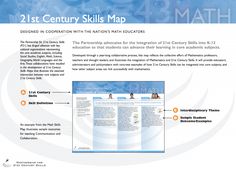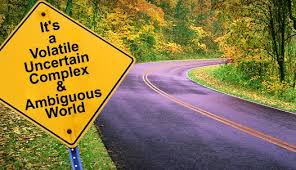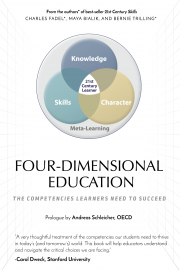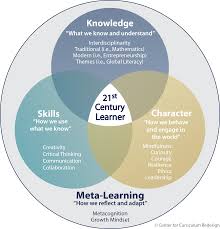V.U.C.A. originated as a military term to describe the context in which soldiers operate in a theatre of war. It stands for:
Volitility
Uncertainty
Complexity
Ambiguity
It is the new normal for our students, and (as the authors of this book do a great job of emphasizing) it is the new normal for our teachers as well. VUCA is an acronym that can inspire anxiety and even fear in parents, teachers and students. However, what this book does is provide strategies and systems to support students and teachers in not only surviving, but thriving in the new normal.
You would be interested in reading this book for:
1) A quick and broad look at the changing landscape of CURRICULUM
2) An effective synopsis of WHY curriculum must change
3) A detailed theoretical look at these changes in the area of Curriculum, Skills and Character
4) A better understanding of the need for meta-cognition for our teachers and students
We cannot solve our problems with the same thinking that we used to create them – Albert Einstein
This book is authored by the Center for Curriculum Redesign, and as such it focuses on the need for curriculum change. But it does so in the larger context of the other 3 dimensions of education:
Knowledge is broken down into two categories: stable and niche (my words). This book posits that a rethink of WHAT we teach is required, such that we many give students the stable knowledge upon which to think critically, as well as the innovative skills and emerging knowledge that are required for success in today’s future world. They put forth that curriculum should be analyzed to find what knowledge is relatively stable, and what can be discarded, left for niche courses (usually at a higher level of study). It is the stable knowledge that forms the core of the new curriculum; however, with the discarded pieces, teachers can now embed innovative mindsets, new knowledge-skills (like critical thinking, validating resources, etc…).
For example, I am a history buff, and history teacher. One of the hardest decisions that I have had to make was narrowing the focus of study of the World Wars. While the history is rich, the narratives within compelling, and of great interest, they were serving as the bulk of the curriculum. However, to truly serve my students, I felt that I needed to curtail the study of the World Wars to ensure that they gained a complex understanding of the post-cold war world in which they live. This is what this book advocates for, the difficult choices as educators to surrender their curriculum loves (like the World Wars for me) and build a curriculum that continues to capture their imagination, but also serves to inform them and engage them in the complexity of their own world.
The future ain’t what it used to be… Yogi Berra
“We are drowning in information, while starving for wisdom.” (EO Wilson) is the quotation with which this book opens up the chapter entitled “A 21st Century Competencies Framework”. In it, the authors emphasize that the world will be run by those that can synthesize and make meaning from the wealth of information and data through critical thinking, integrated thinking and design thinking.
Silo-busting has become common place in educational change – the notion that we must look to integrate the learning and connect the experiences from one discipline to another in knowledge, skills and assessment. This book puts forth a framework to make this happen: Meta-concepts.
Meta-concepts are concepts that are inherently overarching across the discipline and sometime beyond, to other disciplines, rather than limited to a given subject itself.
For example, the concept of validity or proof extends from research skills in the Social Sciences and English to Mathematics and Physics. The concept of proof, then, is a meta-concept worthy of exploration as a more fulsome experience for our learners. (pg. 79)
This book mentions the P21 Skills Map project where they map the P21 skills on top of curriculum. This is a great example, and one worth exploring for you own school and with your teachers. 
For example, if you are a school that has creative thinking as a value, then these Maps show you how to integrate creative thinking into a variety of subjects.
“The best way to capture moments is to pay attention. This is how we cultivate mindfulness. Mindfulness means being awake. It means knowing what you are doing.” ~Jon Kabat-Zinn
The most compelling piece of this book, for me, is its emphasis on meta-learning. The use of metacognition, mindfulness and reflection as the heart of learning. “Even brief mindfulness meditation trainings have been shown to reduce fatigue and anxiety, and improve visual-spatial processing, working memory, and executive functioning.” (pg. 132) I have long been an advocate and practitioner of mindfulness in my own life/work, and bringing it to my schools. But it is in this book that this concept of meta-learning gets paid special attention. It is meta-learning that supports the development of skills to support us in VUCA. It is mindfulness that opens up ourselves to ourselves first and foremost to know ourselves as a learner. It is mindfulness that can support the development of empathy.
When we ask students to verbalize explanations of verbal or non-verbal knowledge we are improving their ability to problem solve. (pg. 149) Isn’t this the learning we want for our students?
If VUCA is the new normal, this book shows us what the new normal should be for our schools. 

